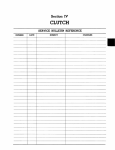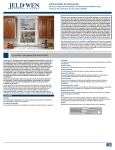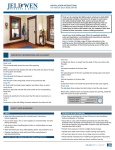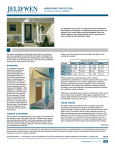Download JELD-WEN H84760 Instructions / Assembly
Transcript
Installation & finishing instructions for Interior & Exterior Wood Door Slabs storage & Handling Improper storage, handling, finishing and installation of wood doors may result in severe damage to the doors. Follow these guidelines to help maintain the high-quality of the product. 1.Allow doors to acclimate for at least 24 hours to local conditions before installation or finishing. Store doors flat on a level surface in a dry, well-ventilated building. Doors should be kept at least 3 1/2" off the floor and should have protective coverings under the bottom door and over the top. Covering should protect doors from dirt, water and abuse, but allow for air circulation under and around the stack. Avoid exposure to direct sunlight. 2.Do not subject interior doors to extremes of heat and/or humidity. Prolonged exposure may cause damage. Buildings where humidity and temperature are controlled provide the best storage facilities (recommended conditions 30%-50% RH and 30°F to 90°F). 3.Do not install doors in buildings that have wet plaster or cement unless they have been properly finished. Do not store doors in buildings with excessive moisture content - HVAC systems should be operating and balanced. 4.Doors should always be handled with clean hands or while wearing clean gloves. 5.Doors should be lifted and carried when being moved, not dragged across one another. prepare door 1.Inspect slabs prior to hanging them on the job. Repair noticeable marks or defects that may have occurred from improper storage and handling. 2.Field touch-up is the responsibility of the installer and includes filling of exposed nail or screw holes, refinishing of raw surfaces resulting from job fitting, repair of job inflicted scratches and mars, and final cleaning of finished surfaces. 3.When cleaning door surfaces, use a non-abrasive commercial cleaner designed for cleaning wood door or paneling surfaces that does not leave a film residue that would build up or affect the surface gloss of the door finish. 4.Before finishing, hang the door. Then remove to finish properly. 4.All hardware locations, preparations for hardware and methods of hardware attachments must be appropriate for the specific door construction. Templates for specific hardware preparation are available from hardware manufacturers. 5. Pilot holes must be drilled for all screws that act as hardware attachments. Screws that are threaded to the head are preferable for fastening hardware to nonrated doors and are required on fire-rated doors. finishing All six sides of the slab as well as cutouts for hardware must be finished to ensure uniform moisture exposure and dimensional control. Failure to finish as directed may result in denial of warranty claims. Basic Finishing Recommendations • Use only one manufacture's products and follow all manufacturer's instructions. • Stile and Rail panels can float. Carefully realign with a wood block and hammer as necessary. • Certain species of wood contain chemicals that react unfavorably to some finishes or to foreign materials in the finishing system. Where possible, test your finish prior to application and eliminate the use of steel wool on bare wood, rusty containers or any other contaminate. • Most finishes perform better if protected from sunlight and weathering. If door is exposed to direct sunlight, avoid dark colored finishes. This will reduce the chance of warping, veneer checking or sunburn. • Multiple light coats are better than one heavy coat. Be sure the door surface being finished is satisfactory in both smoothness and color after each coat. Allow adequate drying time between coats. • Doors with clear glass require special care. Finish should flow from wood slightly onto glass to prevent water leakage and protect glazing putty. Prepare to Finish 1.Door must be dry before finishing. 2.Remove all handling marks, raised grain, scuffs, burnishes and other undesirable blemishes by block sanding all surfaces in a horizontal position with 120, 150 or 180 grit sandpaper. To avoid cross-grain scratches, sand with the grain. installation 3.After sanding, clean entire door with a cloth, removing all dust and foreign debris. (Avoid caustic or abrasive materials.) 1.The utility or structural strength of the doors must not be impaired in fitting to the opening, in applying hardware, preparing for lights, louvers, plants-on or other detailing. 4.We recommend applying a pre stain conditioner prior to staining to promote a uniform appearance and avoid sharp color contrasts or a blotchy appearance. 2.Use a minimum of two hinges for JELD-WEN 1 3/8" doors up to 80" in height, three hinges for all 1 3/4" doors and all doors up to 84" in height and four hinges for doors over 84" up to 96" in height. 5.Oil-based sealers or primer coats provide the best base coat for finishing. If a water-based primer is used it should be an exterior grade product. Note: Water-based coating on unfinished wood may cause veneer splits, highlight joints and raised wood grain, and therefore should be avoided. If a water-based primer is desired, please contact the finish supplier regarding the correct application and use of these products. 3.Clearances between door edges and door frame should be a minimum of 1/16" on the hinge edge. For latch edge and top rail, the clearance should be 1/8" (+0", -1/16"). The information contained herein is provided solely for informational and/or educational purposes. JELD-WEN disclaims any and all liability associated with the use and/or provision of this information. Any reliance upon the information or advice is at the risk of the party so relying. The information contained herein may be changed from time to time without notification. © 2010 JELD-WEN, inc. | JELD-WEN, the JW icon and Reliability for real life are trademarks or registered trademarks of JELD-WEN, inc., Oregon, USA. (10/10) Installation & finishing instructions for Interior & Exterior Wood Door Slabs finishing - continued adjustment & maintenance 6.Choose a top coat that is appropriate for the application (i.e. exterior grade products for exterior applications). 1.Ensure that all doors swing freely and do not bind in their frame. Adjust the finish hardware for proper alignment, smooth operation and proper latching without unnecessary force or excessive clearance. Stain and Clear Finishing 1.To color and seal, make first coat a stain-and-sealer with alkydresin base. (Lacquer-based toner and lacquer-based finishes are only allowed for interior applications, not for exterior applications.) 2.Top coat may be an oil-base, alkyd resin-base, polyurethane resin-base or latex resin-base clear finish. A marine-grade varnish is recommended on all wood exterior doors. For best results, apply at least two topcoats. Paint Finish If the door is not primed, use a good quality oil-based primer. Paint with at least two topcoats of good quality oil-based or water-based acrylic latex paint. 2 2.Periodically inspect all doors and hardware (at least once a year, more often in harsh climates) for wear, damage and natural deterioration. Repair, refinish or replace product as necessary and adjust all hardware to ensure that it continues to function as it was originally intended.













